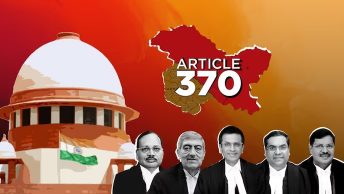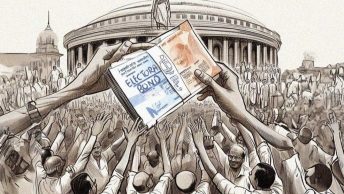- INTRODUCTION
Justice Arun Mishra retired from the Supreme Court of India on September 2, 2020. A plethora of articles have been written since, which have attempted to unpack the judicial legacy of Justice Mishra. The articles analysing the judicial career of Justice Mishra open by emphasising on his noticeable presence during his 5-year long tenure at the Supreme Court. Most articles then go on to criticise his controversial judgements and throw light on his notice-worthy judgements. This post aims to analyse the various perspectives presented by different articles on Justice Mishra’s tenure in order to present a critical commentary on his judicial legacy.
- POLITICAL NEXUS & DEFERENCE TO THE CENTRE
A common theme among different articles links Justice Mishra’s alleged political connections with his deference towards the Centre in his judgements. A further consequentialist extension of this argument is that his executive-minded decisions have been detrimental for the independence of the judiciary and its judicial review function.
Venkatesan in the first of his five-part series for the Wire, makes a remark on the political connections of Justice Mishra, particularly with the current ruling party in context of the Sahara-Birla diaries case regarding failure of the Income Tax department to hand over documents showing entries of payment of bribes, which included names of BJP leaders including PM Narendra Modi. In continuation of this theme, Manu Sebastian for LiveLaw, reviews Justice Mishra’s verdicts in light of the allegations regarding his political connections with BJP politicians who have been captured at his residence for family functions.
Next, Venkatesan argues that Justice Mishra’s judgements were usually in favour of the Centre and “almost predictable”. He questions whether such predictability suggests that the judge has already decided the outcome of the case. Venkatesan thus draws the following inference after analysing multiple judgements – Justice Mishra invariably ruled in favour of the State, when it was the appellant and except in a few controversial exceptions, he mostly ruled in favour of the State when it was the respondent. Venkatesan concludes his series by arguing that Justice Mishra always deferred to the Centre when the onus of justifying that the law could be protected in case of violation of a constitutional provision lay on the State. He unpacks various judgements and highlights the sole exception of Rajendra Diwan v Pradeep Kumar Ranibalawhere Justice Mishra, as part of a Constitution bench, went against a statute and declared it null and void.
Taking this point further, Ananthakrishnan G for the Indian Express states that Justice Mishra’s critics felt that his decisions resulted in a dilution of the judiciary’s check-and-balance role, especially in context of questioning the executive. A similar critique is made by Faizan Mustafa and Pranav Verma for the Deccan Chronicle as they review the executive-minded judgements of Justice Mishra in context of weakening of the counter-majoritarian measures undertaken by an independent judiciary.
- CONTROVERSIAL VERDICTS IN CRITICAL CASES
As a continuation of the previous theme, this section notes that Justice Mishra was often assigned politically and commercially sensitive cases. Meera Emmanuel and Lydia Suzanne Thomas for Bar and Bench, give a brief summary of such important verdicts – Adjusted Gross Revenue (AGR) case giving timeline for payment of dues, the Prashant Bhushan contempt case, the case giving Hindu daughters equal inheritance rights, judgement quashing 100% reservation for STs in Scheduled Areas, refusal to recuse in the Land Acquisition Act case, judgement for eviction of STs and other traditional forest dwellers from forest land, impeachment case against Justice Dipak Misra, the Fodder Scam case, case upholding the constitutionality of the NCLT and NCLAT, Sanjiv Bhatt case absolving the then additional advocate general Tushar Mehta of contempt charges etc. A detailed analysis of these cases can be found in the 5 part series by Venkatesan and the article by Suhrith Parthasarathy & Gulnar Mistry for Bloomberg Quint. A similar and equally detailed critical analysis of major verdicts given by Justice Mishra is covered by Anup Surendranath, Aparna Chandra and Suchindran Baskar Narayan writing for Article 14. They unpack his verdicts under the following themes: nepotism in the judiciary, favouritism among CJIs, delay and unseemly hastening of specific cases, disregard for judicial precedents, lack of sufficient judicial rigour and authoritarian tendencies. Sriram Panchu writing for Bar and Bench also provides a detailed commentary here.
- PROXIMITY TO SUCCESSIVE CJIs
Justice Mishra was preferred by successive CJIs for assignment of politically significant cases, on multiple occasions, despite being lower in seniority. This had resulted in the press conference by four senior judges of the Supreme Court on January 12, 2018 where they had noted their dissatisfaction with the assignment of politically sensitive cases to Justice Mishra, circumventing the roster system. Rekha Sharma writing for the Indian Express traces this pattern starting from Justice Loya’s case being assigned to Justice Mishra by CJI Dipak Misra, ignoring nine other judges senior to him. Venkatesan, presents other controversial decisions including a defamation case against the Wire by Jay Amit Shah, which ordinarily should have been heard by Justice D.Y. Chandrachud or Justice A.M. Khanwilkar, but was heard by a different 3 judge bench with Justice Mishra.
Next, Venkatesan notes how Justice Mishra managed to gain trust of successive CJIs who not only asked him to author judgments on their behalf, but also assigned politically controversial cases to benches presided by him or of which he was a part. In this context, the author cites multiple case law illustrations where Justice Mishra was involved, the two most note-worthy being as follows – firstly, Justice Mishra’s role in dismissal of the petition in the medical college bribery case which involved allegations against then CJI Dipak Misra and secondly, Justice Mishra being drafted by CJI Ranjan Gogoi to be a part of the controversial bench that dismissed a sexual harassment charge against the CJI himself.
Taking this argument further, Parthasarathy & Mistry, writing for Bloomberg Quint here compare the legacy of Justice Mishra as overshadowing that of even the CJIs during his tenure at the Apex Court. The archetype of Justice Mishra’s career according to them was proclivity for embossing on rule of law his own style of justice that often related in negation of constitutional principles such as personal liberty. Parthasarathy & Mistry further unpack Justice Mishra’s decisions on matters of personal liberty, for example, the controversial dismissals in habeas corpus cases arising from the abolition of Jammu and Kashmir’s special status in August 2019 and subsequent detention of politicians. It discusses other cases, for example, Justice Mishra setting aside a Delhi High Court intervention inquiring into grounds for Gautam Navlakha’s case being removed from its jurisdiction. Another instance, noted by Manu Sebastian here, discusses how a bench headed by Justice Mishra dismissed the petitions by Anand Teltumbde and Gautam Navlakha challenging the Bombay HC verdict denying them bail.
- DISREGARD FOR JUDICIAL DISCIPLINE
As argued here, Justice Mishra’s verdicts raise questions of appropriate judicial conduct and public confidence in the judiciary. Arguments are made criticising the influence of his ideological leanings on his judgements, the ignorance of precedents and disregard of due process in his rulings.
Venkatesan also argues that Justice Mishra’s personal values based on social conservatism reflect in his judgements on state policy for places of worship, obscenity and gender justice. The article is based on the premise that Justice Mishra’s judicial decision-making philosophy and ideological leanings played a role in his “neglect of those judicial precedents”. It elucidates on multiple cases involving religious questions where the judgements heavily emphasised on proper facilitation of Hindu rituals failing to separate them from secular activities.
Under the next sub-theme, Venkatesan illustrates how Justice Mishra’s judgements show disregard for judicial discipline and the principle of stare decisis. Venkatesan elucidates on how Justice Mishra’s reasonings given in one of the cases regarding anticipatory bail goes against his own prior judgement. Venkatesan calls this a “lack of judicial discipline”, which is a “characteristic of his judicial interventions.” It presents multiple judgements as evidence to show how Justice Mishra’s reasonings went against precedents, both which his judgements did and did not rely on, some even his own. Here, the article explores different problematic judgements under the following themes – land acquisition matters, free speech rights, revival of creamy layer debates and favouring the Adani group in crucial matters.
Continuing this line of thought, the next set of articles illustrate how Justice Mishra’s verdicts reveal a pattern of indifference towards due process of law. Sriram Panchu mentions how Justice Mishra restored a conviction, in the case involving murder of Haren Pandya – the Gujarat Home Minister, without following the due procedure of reversing an acquittal. Rekha Sharma elucidates on how Justice Mishra leading a constitutional bench in the Land Acquisition case violated principles of natural justice. Manu Sebastian draws a link of the Adani cases with contravention of the SC roster and out-of-turn listing of cases. The author analyses another set of verdicts by Justice Mishra to state that his tendency to “jump to quick conclusions” show a disregard for due procedure. The article also goes on to mention the instances when the bench led by Justice Mishra backtracked from its own orders at the instance of the Union Government – one being staying of an eviction notice passed to remove forest dwellers and second being the notice to raze down the Guru Ravidas Temple of Delhi. It also looks at Justice Mishra’s alleged role in appointment of his younger brother, Vishal Mishra as a judge at the Madhya Pradesh High Court and his name being cleared by the Supreme Court collegium, raising important questions regarding nepotism in the Indian judiciary.
- POLITICAL INCORRECTNESS & TEMPERAMENTAL OUTBURSTS
Justice Mishra had multiple clashes with the bar for politically incorrect statements made by him both in and outside the Court. Rekha Sharma notes that Justice Mishra’s temperament in the Court often compelled the Bar to protest. In one instance, Justice Mishra had “named and shamed” a sitting Kerala High Court judge in open Court. This article by Aditya AK for Bar and Bench calls these brash outbursts his “passion”, which manifested in a negative way. It focuses on the controversial statements made by Justice Mishra that gave him the name of the “Iron Judge”. This includes his statement praising PM Modi as a “versatile genius” at the International Judicial Conference, which was heavily criticised. Taking this narrative forward, Ananthkrishnan G comments on Justice Mishra’s jabs in Court hearings, for example, calling himself a “junior judge” and linking his criticism of praising Modi to that of a praising a senior counsel in Court.
- NOTEWORTHY JUDGEMENTS
In addition to focusing on the shortcomings in Justice Mishra’s judicial pronouncements, Ananthkrishnan G also presentshis supporters’ arguments that criticism against Justice Mishra is politically motivated and his record is more nuanced. For example, it cites his pro-environment judgements restraining the construction in Aravalli Hills and ordering time-bound action for pollution in NCR. Parthasarathy & Mistry also note different judgements of Justice Mishra that were praised – for example, the landmark judgement that re-established right of adverse possession under Indian law as being open to both a plaintiff and the defendant. Lastly, Manu Sebastian, here, provides a list of 20 notable (and less controversial) decisions of Justice Mishra. In concluding remarks, the author states that Justice Mishra, a highly productive judge with noteworthy judgements, displayed a perfunctory approach in cases related to civil liberties and free speech and his pro-executive stance strengthened allegations of his perceived closeness with the ruling party.
- CONCLUSION
Often called “a man of all seasons”, Justice Mishra was a part of 540 benches and gave as many as 132 judgements. He was given the title of the “Iron Judge of the Supreme court” and was praised for his noteworthy verdicts. His juniors described him as kind-hearted, generous and hardworking. However, his judicial legacy faced severe criticism on multiple fronts and his controversial judgements were condemned by members of the legal community and media alike. As he exited office on September 2, 2020, Justice Mishra denied a farewell on account of the Covid-19 pandemic, stated that he dealt with every case with his conscience, and implored critics not to give “colour” to his judgments.
The following is a list of articles that were analysed in this post (in no particular order):
- Venkatesan, How Justice Arun Mishra Rose to Become the Most Influential Judge in the Supreme Court, The Wire ( September 1, 2020).
- Venkatesan, Justice Arun Mishra’s Social Conservatism a Key Factor in His Neglect of Judicial Precedents, The Wire (September 2, 2020).
- Venkatesan, As Judge, Arun Mishra Was Almost Predictable When the State Was Before Him ,The Wire (September 3, 2020).
- Venkatesan, Justice Arun Mishra’s Disregard for Precedent Led to Charge of Judicial Indiscipline, The Wire (September 4, 2020).
- Venkatesan, In Deciding Constitutionality of Enactments, Justice Arun Mishra Always Deferred to Centre , The Wire, (September 5, 2020).
- Anup Surendranath, Aparna Chandra & Suchindran Baskar Narayan, Justice Arun Mishra & The Supreme Court’s Rule Of Whim, Article 14, (September 5, 2020).
- Faizan Mustafa & Pranav Verma, Justice A.K. Mishra: A controversial judge with a tumultuous legacy, Deccan Chronicle, (September 7, 2020).
- Suhrith Parthasarthy & Gulnar Mistry, A Sui Generis Style: Justice Arun Mishra On The Supreme Court, Bloomberg Quint, (September 2, 2020).
- Manu Sebastian, Justice Arun Mishra’s Controversial Tenure Leaves Questions On Public Confidence In Judiciary, LiveLaw, (September 2, 2020).
- Aditya AK, If I uttered something, I never meant anything”: The controversial statements made by Justice Arun Mishra, Bar and Bench, (September 3, 2020).
- Meera Emmanuel & Lydia Suzanne Thomas, Land Acquisition Act, AGR, Master of Roster and more: The important judgments passed by Justice Arun Mishra as a Supreme Court judge, Bar and Bench, (September 2, 2020).
- Rekha Sharma, Justice Arun Mishra’s legacy casts a shadow over country’s highest court at a critical moment, The Indian Express, (September 3, 2020).
- Ananthakrishnan G, Justice Arun Mishra retires today, leaving contested SC legacy, The Indian Express, (September 2, 2020).
- Sriram Panchu, Justice Arun Mishra: An assessment, Bar and Bench, (September 13, 2020).







Congrats Shravani. It is a nice compendium of different articles on the controversial tenure of Arun Mishra. You have deftly dealt with the different views without expressing your own opinion. Good mediator quality.
Your article helped me a lot, is there any more related content? Thanks!